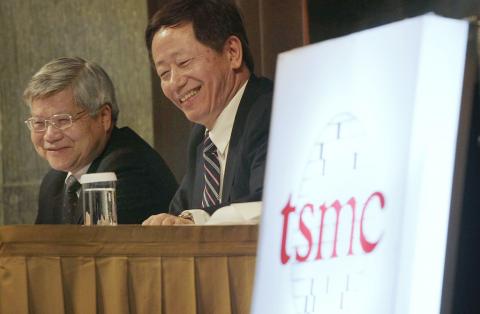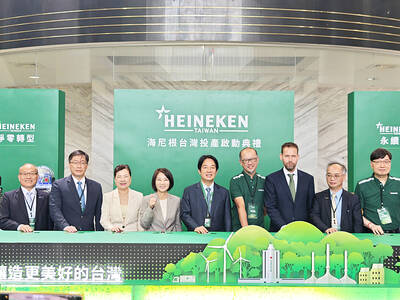Taiwan Semiconductor Manufacturing Co (TSMC, 台積電) yesterday forecast better-than-expected sequential growth of 22 percent in revenue this quarter after the world’s top contract chipmaker posted a quarterly net profit that beat analysts’ expectations, fueled by resilient smartphone demand.
Revenue is expected to swell to between NT$180 billion and NT$183 billion (US$5.97 billion and 6.07 billion) in the current quarter, compared with NT$148.22 billion last quarter, with the strongest growth from the communications segment, TSMC chief financial executive officer Lora Ho (何麗梅) said.
The “unseasonably strong” growth cited by TSMC exceeds the 15 percent sequential expansion estimated by Credit Suisse analyst Randy Abrams. He forecast that TSMC’s revenue would expand to NT$169 billion this quarter.

Photo: Reuters / Pichi Chuang
Abrams retained his “outperform” rating on TSMC with a target price of NT$130.
“Since mid-January, we started to see strong orders across all segments. We now adjust our demand outlook,” TSMC co-CEO Mark Liu (劉德音) said. “First, the demand for smartphones appears healthier than we expect. Second, our 28-nanometer technology’s performance and quality have helped fuel more customer demand.”
As inventory for chip designers remains lower this quarter than the typical seasonal level, “we expect that our demand will continue to be strong and above seasonal [norms] in all major regions,” Liu said.
Liu said the company would also see positive sequential growth in the third and fourth quarters, but the growth would “be normal and be more moderate than the second quarter,” as customers’ inventory would return to seasonal levels in the middle of this year, he said.
TSMC said it is to ship a high volume of 20-nanometer chips in the second half of this year and start mass production of next-generation 16-nanometer chips next year as scheduled.
The company expects the global semiconductor industry to see revenue grow by 7 percent annually this year, compared with a 5 percent increase estimated three months ago, and chip designers would see revenue rise by 9 percent annually from 8 percent previously forecast, Liu said.
The chip foundry industry would expand revenue by 14 percent this year, up from an earlier 10 percent prediction, Liu said. TSMC’s revenue growth this year would outpace the rest of the industry by several percentage points, he said.
During the quarter ending March 31, TSMC’s net profit expanded 6.8 percent to NT$47.87 billion, or NT1.85 per share, compared with NT$44.81 billion, or NT$1.73 per share, in the fourth quarter of last year. On an annual basis, the figure represented a growth of 21 percent.
Gross margin improved to 47.5 percent last quarter from 44.5 percent in the fourth quarter of last year, while operating profit margin rose to 35.4 percent from 32.8 percent.
This quarter, TSMC expects gross margin to climb to between 47.5 percent and 49.9 percent, while operating profit will rise to between 36.5 percent and 38.5 percent.
Liu said revenue contribution from high-end smartphones would rise to US$14 per unit this year, from US$10.8 last year.

purpose: Tesla’s CEO sought to meet senior Chinese officials to discuss the rollout of its ‘full self-driving’ software in China and approval to transfer data they had collected Tesla Inc CEO Elon Musk arrived in Beijing yesterday on an unannounced visit, where he is expected to meet senior officials to discuss the rollout of "full self-driving" (FSD) software and permission to transfer data overseas, according to a person with knowledge of the matter. Chinese state media reported that he met Premier Li Qiang (李強) in Beijing, during which Li told Musk that Tesla's development in China could be regarded as a successful example of US-China economic and trade cooperation. Musk confirmed his meeting with the premier yesterday with a post on social media platform X. "Honored to meet with Premier Li

Dutch brewing company Heineken NV on Friday announced an investment of NT$13.5 billion (US$414.62 million) over the next five years in Taiwan. The first multinational brewing company to operate in Taiwan, Heineken made the statement at a ceremony held at its brewery in Pingtung County. It also outlined its efforts to make the brewery “net zero” by 2030. Heineken has been in the Taiwanese market for 20 years, Heineken Taiwan managing director Jeff Wu (吳建甫) said. With strong support from local consumers, the Dutch brewery decided to transition from sales to manufacturing in the country, Wu said. Heineken assumed majority ownership and management rights

coverage expansion: The industrial PC maker has proposed to acquire 3.938 million Aures shares to strengthen its global smart retail presence Leading industrial PC maker Advantech Co (研華) plans to acquire Aures Technologies SA, a French company known for its point-of-sale (POS) and kiosk equipment, to expand its global coverage in smart retail products and services. Advantech proposed to acquire 3.938 million Aures shares from the French firm’s major shareholder and through a public tender offer at up to 6.7 euros per share, the PC maker said in a statement after announcing the deal at the Taiwan Stock Exchange late on Friday. The company aims to acquire up to 100 percent equity of Aures, a well-known brand in the western market with a

Microsoft Corp yesterday said that it would create Thailand’s first data center region to boost cloud and artificial intelligence (AI) infrastructure, promising AI training to more than 100,000 people to develop tech. Bangkok is a key economic player in Southeast Asia, but it has lagged behind Indonesia and Singapore when it comes to the tech industry. Thailand has an “incredible opportunity to build a digital-first, AI-powered future,” Microsoft chairman and chief executive officer Satya Nadella said at an event in Bangkok. Data center regions are physical locations that store computing infrastructure, allowing secure and reliable access to cloud platforms. The global embrace of AI